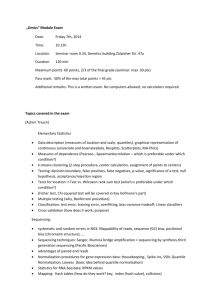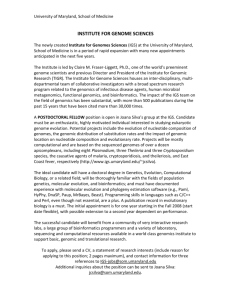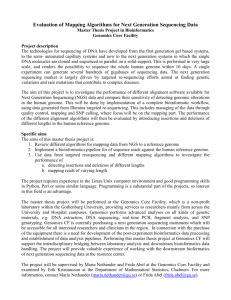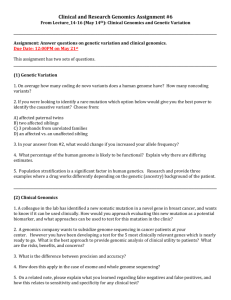Biology 468 BYU
advertisement
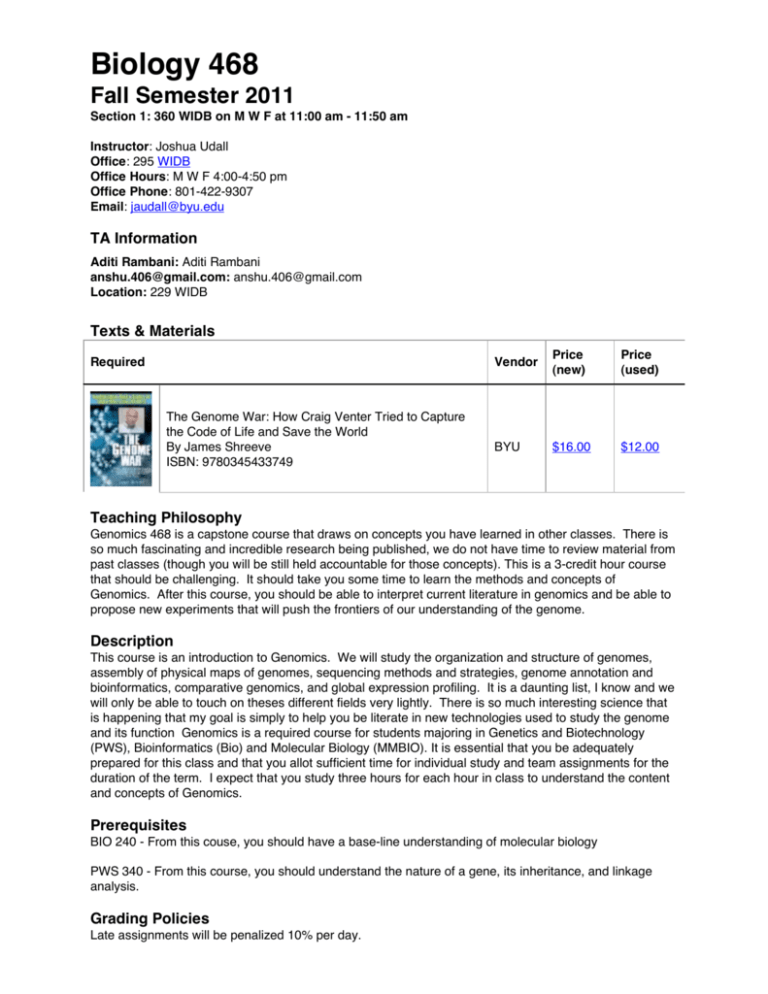
Biology 468 Fall Semester 2011 Section 1: 360 WIDB on M W F at 11:00 am - 11:50 am Instructor: Joshua Udall Office: 295 WIDB Office Hours: M W F 4:00-4:50 pm Office Phone: 801-422-9307 Email: jaudall@byu.edu TA Information Aditi Rambani: Aditi Rambani anshu.406@gmail.com: anshu.406@gmail.com Location: 229 WIDB Texts & Materials Required The Genome War: How Craig Venter Tried to Capture the Code of Life and Save the World By James Shreeve ISBN: 9780345433749 Vendor Price (new) Price (used) BYU $16.00 $12.00 Teaching Philosophy Genomics 468 is a capstone course that draws on concepts you have learned in other classes. There is so much fascinating and incredible research being published, we do not have time to review material from past classes (though you will be still held accountable for those concepts). This is a 3-credit hour course that should be challenging. It should take you some time to learn the methods and concepts of Genomics. After this course, you should be able to interpret current literature in genomics and be able to propose new experiments that will push the frontiers of our understanding of the genome. Description This course is an introduction to Genomics. We will study the organization and structure of genomes, assembly of physical maps of genomes, sequencing methods and strategies, genome annotation and bioinformatics, comparative genomics, and global expression profiling. It is a daunting list, I know and we will only be able to touch on theses different fields very lightly. There is so much interesting science that is happening that my goal is simply to help you be literate in new technologies used to study the genome and its function Genomics is a required course for students majoring in Genetics and Biotechnology (PWS), Bioinformatics (Bio) and Molecular Biology (MMBIO). It is essential that you be adequately prepared for this class and that you allot sufficient time for individual study and team assignments for the duration of the term. I expect that you study three hours for each hour in class to understand the content and concepts of Genomics. Prerequisites BIO 240 - From this couse, you should have a base-line understanding of molecular biology PWS 340 - From this course, you should understand the nature of a gene, its inheritance, and linkage analysis. Grading Policies Late assignments will be penalized 10% per day. The class will not be graded on a curve, so you will not be competing with other students for a grade The course evaluation at the end of the semester will be considered as an assignment. Learning Outcomes • • • • • • Genomic Experiments Students will complete a series of exercises with data representing genomic experiments (analysis and interpret). Genome Sequences Students will describe how genomes are sequenced. Genomic Features Students will understand techniques and concepts to assess genomic features such as methylation, gene expression, etc. Genome Sequencing Students can describe the technology and process used to sequence genomes (de novo and resequencing) Genomic Experiments Students can complete a series of exercises with data representing genomic experiments (analyze and interpret) Genomic Parameters Students can outline techniques and concepts for assessing genomic parameters such as methylation, gene expression, DNA-binding motifs, metagenomics, and comparative genomics. Grading Scale A AB+ B 93-100 90-92 87-89 83-86 BC+ C C- 80-82 77-79 73-76 70-72 D+ D DE 67-69 63-66 60-62 59 and lower Assignment Descriptions HW1 Interpretation of Sequencing Data: HW1 queries your understand of Sanger and 454 sequencing technologies. You are asked to interpret sequence data, describe 454 sequencing in detail, and calculate the values from a sliding window. HW2 Interpretation of sequencing data and personal genomics: This assignment assess your understanding of SOLiD and Illumina sequencing technologies. Every student currently enrolled at BYU will eventually have their genome sequenced. This assignment also encourages you to think about genomics on an individual basis with the introduction of the 'One-in-abillion'. HW 3 Sequence assembly and gene identification: This home work contains a dataset of sequencing reads and you need to assemble them into as few a number of contigs as possible and in the largest contig, use glimmer to identify possible genes residing in the sequence. HW4 Genome Size and Duplications: This home work as a calculation problem of the number of clones in a library, conversion of pg to bp, etc. There are also some basic questions regarding genome size. HW5 ESTs and Gene Annotation: This assignment has you assemble EST sequences, identify ORFs, and get a putative function of the protein sequence using blast. HW6 RNA-seq: This assignment uses reference mapping to align mRNA-seq reads to a reference sequence. The number of reads that align to a gene quantify gene expression. You are to test for differential expression between two data sets using the Galaxy web-suite. HW7 Target Enrichment: Target enrichment includes methods used to only sequence a portion of the genome. We will use data from a real traget enrichment experiment to identify sequence variants with a gene sequence between different varieties of plants. HW9 ChIP-seq: ChIP-seq is a molecular technique that uses sequence to identify potential transcription factor binding sites (or other DNA binding sites that may reside in the genome). We will use Galaxy to identify peaks in ChIP seq data from Illumina sequencing. HW10 Metagenomics: Metagenomics is a nacent field of biology that uses DNA sequencing to identify organisms in particular environmental samples. This assignment uses data collected from a biofilm in Diamond Fork produced by an unknown microbe. HW11 SNP Genotyping: We will use data collected from next-generation sequencing to identify SNPs between different plant varieties. Book Review: A book review of 'The Genome War' Class presentation: Your group will present at least 2 current papers applying sequencing technology to genomic research. Please meet with me 2 weeks prior to your presentation to identify the papers and discuss methods of presenting the material to the class. Mid-Term 1: Exam covering the first portion of the course. Mid-Term 2: Exam covering the second portion of the course. Course Evaluation: The course evaluations are seriously considered. In grading terms that you are familiar with, a score of 8 is equal to an 'A' and a score of 5 is equal to a 'D-'. Please take a moment to fill out the evaluation. I cannot see the names of the students associated with your evaluation. Final Exam: A Comprehensive Final exam. It will be weighted in its coverage of the different portions of the course: 25% (Midterm 1), 25% (Midterm 2), and 50% (remainder fo the course). HW8 DNA methylation: We will map BS-converted DNA sequences to a reference genome and 1) quantify the number of spots that were methylated, 2) indentify locals of differential methylation, and 3) examine hemi-methylation with our sampled reads. Point Breakdown Assignments Points HW1 Interpretation of Sequencing Data 20 HW2 Interpretation of sequencing data and personal genomics 20 Book Review 25 HW3 Sequence assembly and gene 20 Assignments Points identification Mid-Term 1 100 HW4 Genome Size and Duplications 20 HW5 ESTs and Gene Annotation 20 HW6 RNA-seq 20 HW7 Target Enrichment 20 Mid-Term 2 100 HW8 DNA methylation 20 HW9 ChIP-seq 20 HW10 Metagenomics 20 HW11 SNP Genotyping 20 Class presentation 50 Final Exam 100 Course Evaluation Total Points 10 605 Librarian Information Name: Richard Jensen Office: 2324 HBLL Phone Number: 422-6012 Email: richard_jensen@byu.edu Reference Desk Information Name: Science / Maps Phone Number: 422-2987 Email: science_reference@byu.edu Hours: M-Th : 8am-9pm; F: 8am-6pm; Sat: 10am-6pm Department Research Information http://guides.lib.byu.edu/content.php?pid=50686 E-reserve Information http://www.lib.byu.edu/reserve.html BYU Honor Code In keeping with the principles of the BYU Honor Code, students are expected to be honest in all of their academic work. Academic honesty means, most fundamentally, that any work you present as your own must in fact be your own work and not that of another. Violations of this principle may result in a failing grade in the course and additional disciplinary action by the university. Students are also expected to adhere to the Dress and Grooming Standards. Adherence demonstrates respect for yourself and others and ensures an effective learning and working environment. It is the university's expectation, and my own expectation in class, that each student will abide by all Honor Code standards. Please call the Honor Code Office at 422-2847 if you have questions about those standards. Preventing Sexual Discrimination and Harassment Title IX of the Education Amendments of 1972 prohibits sex discrimination against any participant in an educational program or activity that receives federal funds. The act is intended to eliminate sex discrimination in education. Title IX covers discrimination in programs, admissions, activities, and studentto-student sexual harassment. BYU's policy against sexual harassment extends not only to employees of the university, but to students as well. If you encounter unlawful sexual harassment or gender-based discrimination, please talk to your professor; contact the Equal Employment Office at 422-5895 or 3675689 (24-hours); or contact the Honor Code Office at 422-2847. Students with Disabilities Brigham Young University is committed to providing a working and learning atmosphere that reasonably accommodates qualified persons with disabilities. If you have any disability which may impair your ability to complete this course successfully, please contact the Services for Students with Disabilities Office (422-2767). Reasonable academic accommodations are reviewed for all students who have qualified, documented disabilities. Services are coordinated with the student and instructor by the SSD Office. If you need assistance or if you feel you have been unlawfully discriminated against on the basis of disability, you may seek resolution through established grievance policy and procedures by contacting the Equal Employment Office at 422-5895, D-285 ASB. Computer policy Computers in the classroom: I will use the computer at the podium to look-up concepts, movies, blackboard, etc. on the internet. You are welcome to follow along on your own laptop. There is wireless in our classroom and that presents a large temptation to multitask while listening to class (Facebook, sports, news, email, etc.). Please understand that your pages are visible to everyone who sits behind you. If your computer activity is distracting to my teaching, I will ask you to put your computer away. Students, if the computers of other students in the classroom are distracting your learning, please let me know and I will also ask the student to either change their activity or put the computer away. Computers in the lab: These computers are primarily to be used for completion of the homework. Since there are not enough computers for each student, if you are done please move over an let other students work. Please do you social and casual surfing elsewhere.





